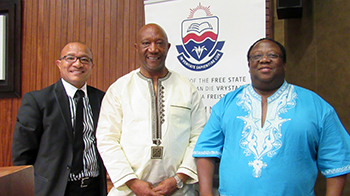Latest News Archive
Please select Category, Year, and then Month to display items
05 June 2018
Photo Supplied
 Archaeological excavations in the Wonderwerk Cave, north of Kuruman in the Northern Cape.
Archaeological excavations in the Wonderwerk Cave, north of Kuruman in the Northern Cape.
Research fellow Dr Lloyd Rossouw from the Department of Plant Sciences at the University of the Free State (UFS) recently published an article in the Nature Ecology and Evolution journal with Dr Michaela Ecker from the University of Toronto as lead author, and Dr James Brink, research fellow at the UFS Centre for Environmental Management. The findings described in “The palaeoecological context of the Oldowan-Acheulean in southern Africa” provides the first extensive paleoenvironmental sequence for the interior of southern Africa by applying a combination of methods for environmental reconstruction at Wonderwerk Cave, which have yielded multiple evidence of early human occupation dating back almost two million years ago.
Where water once was
The Wonderwerk Cave is found north of the Kuruman hills (situated in Northern Cape) a 140m long tube with a low ceiling. The surroundings are harsh. Semi-arid conditions allow for the survival of only hardy bushes, trees, and grasses. But during the Early Pleistocene, stepping out of the Wonderwerk Cave you would have been greeted by a completely different site, the researchers found. Using carbon and oxygen stable isotope analysis on the teeth of herbivores (Dr Ecker), fossil faunal abundance (Dr Brink), as well as the analysis of microscopic plant silica remains (phytoliths) excavated from fossil soils inside the cave (Dr Rossouw), the results show that ancient environments in the central interior of southern Africa were significantly wetter and housed a plant community unlike any other in the modern African savanna.
What difference does it make?
While East African research shows increasing aridity and the spread of summer-rainfall grasslands more than a million years ago, the results from this study indicate an interesting twist. During the same period, shifts in rainfall seasonality allowed for alternating summer and winter-rainfall grass occurrences coupled with prolonged wetlands, that remained major components of Early Pleistocene (more or less the period between one and two million years ago) environments in the central interior of southern Africa. That means our human ancestors were also living and evolving in environments other than the generally accepted open, arid grassland model.
Education is the key to the unification of black and white masses of South Africa
2015-11-13

From left are Dr Victor Teise (Head of School of Higher Education), Dr Mafu Rakometsi (CEO of UMALUSI), and Prof Sechaba Mahlomaholo (Dean of Faculty of Education).
Photo: Valentino Ndaba
|
In view of the divisive nature South Africa’s (SA) schooling system during the pre-1994 period, education appears to be one of the most potent unifying mechanisms of the democratic dispensation. With the elimination of Bantu education and the subsequent gain of access to basic and higher education by the historically-disadvantaged of this country, the schooling system is said to be building and reconstructing bridges which were burnt by the apartheid administration.
This opinion was shared by Dr Mafu Rakometsi, Chief Executive Officer (CEO) of UMALUSI – the Council for Quality Assurance in General and Further Education and Training. Dr Rakometsi, a University of the Free State alumnus, presented a guest lecture titled: “Educational transformation in South Africa – lessons for the future” on Thursday 5 November 2015 at the Bloemfontein Campus.
The discussion of salient matters regarding education and transformation was hosted by the Faculty of Education in collaboration with Institutional Advancement: Alumni.
According to Dr Rakometsi, the transformation of education in SA can be viewed in the same light as that of government; where the nationalist policy was succeeded by democracy. “Education promoted the agenda of ensuring that there was no integration of the South African population,” he said of the past.
“Simply put, in SA, the black person was denied, and deprived of, human rights,” he added. Nonetheless, the declaration of human rights as enshrined in our constitution, and the conviction held by lobby groups, such as the Black Sash, that the young should seek and receive education led to transformation within the education sector.
Although that transformation has been accomplished, poverty continues to hinder access to education. Approximately 80% of the black students in higher education are from poor families, meaning that their parents are unable to fund the completion of their studies. Financial exclusion then translates to social exclusion, which relegates these underprivileged students into narrow enclaves. This results in a counter-transformation situation as a consequence.